How Can We Help You?
Please search these most frequently asked questions to see if one of these answers your question. If not, feel free to reach out to us via our contact page. We don't use BOTs, so you can look forward to communicating with one of our experts!
- General
- Decision making
- Technology
Is the app for my mobile device or my personal computer?
You can run Definitive Choice from your mobile device or tablet using the app, which can be downloaded from the Apple Store® or Google Play Store®). In addition, you can run it using your browser – which allows you to move between the devices using the app and the browser. Your information and decisions are all stored securely on the web so you can access them at any time from any device.
What types of decisions does Definitive Choice support?
Definitive Choice® can be used for any multi-criteria decision that adheres to our guidelines (see below). As soon as you login, you can begin using the service to set up decisions. Our guidelines are as follows: Definitive Choice® must be used to make legal and constructive decisions, with no intention of harming anyone. The criteria and alternatives entered into the service must not be offensive. Definitive Business Solutions has the sole discretion to make this determination. Any content that does not adhere to these guidelines will result in account termination.
What are criteria?
Criteria are measures that are important to making the decision. Often, these are the benefits that you are trying to obtain by making the best decision.
For example, if you are buying a car, your criteria may include fuel efficiency, seating capacity, and color. Some criteria may be very quantitative like fuel efficiency (expressed in miles per gallon or miles between charges), while others are very qualitative like color. One of the strengths of Definitive Choice® is that you can use both types of criteria when setting up your decision, and the results will be synthesized into a total score for each alternative.
How is Definitive Choice different from other decision support software?
Definitive Choice® uses the world’s leading multi-criteria decision-making methodology, the Analytic Hierarchy Process (AHP). It was developed to help decision-makers work through complicated, real-world prioritization scenarios. We advocate the use of AHP based decisions because they are more accurate than single metric prioritization techniques, voting mechanisms, and arbitrarily designed point-based models. For decisions by small teams, Definitive Choice® helps to build consensus decisions without forcing participants to change their judgments. Finally, Definitive Choice® simplifies complex decision-making and helps you make better decisions.
What is the Analytic Hierarchy Process (AHP)?
AHP is based on mathematics and psychology. It simplifies the process of weighing the decision criteria by comparing two criteria at a time (i.e., pairwise comparisons) to determine which is more important with respect to the decision goal – and by how much. Without AHP, decision-makers are left to simply guess their relative importance. The benefits of using AHP include:
- Balancing multiple quantitative and qualitative factors
- Ensuring a comprehensive assessment of each alternative
- Promoting cost vs. benefit analyses
- Providing better decision justification
- Enabling quick reprioritization in response to changing business condition
Do I make the decision by myself, or can I get input from others?
Definitive Choice® is designed to enable either scenario. Although there may be times when a decision is a personal one, we encourage you to consider inviting others to participate in the decision-making process by providing their judgments. Some examples: a project manager making a technology selection decision may want to invite their team members; an entrepreneur making a site selection decision may want to invite the business partners; and a person making a healthcare decision for an aging family member may want to invite other family members. Adding other participants will result in a better decision and can help to remove blind spots that can exist.
Who can I invite to participate in my decisions?
You can invite anyone to help you with a decision. Depending on the type of decision, you may want to consider inviting your colleagues, family members, friends, business partners, or trusted advisors. They do not need to be a Definitive Choice® user and nor do they need a subscription to participate.
If I invite others to participate in my decision, do I need to include their input in the decision?
No. Whether to make your decision based on your own judgment or the judgment of all participants is completely up to you. Even if you want to make the decision based solely on your own judgments, it may be beneficial to invite others to participate. Their perspectives may inform you of something important that you may not be considering. In addition, comparing the results based on your judgments versus the judgments of all participants may help you gain confidence in your decision.
If my employer provides me with access to Definitive Choice, can I use it for other decisions or just the ones that they have set up?
Yes, if you have a subscription from your employer, you may use it to make business or personal decisions. However, it’s important to note that all decisions associated with an employer’s account are accessible to the employer.
Is there a limit to the number of criteria that I use when creating a decision?
Our experience is that most multi-criteria decisions can be made with 4-7 criteria, however there is no limit. Here are two things to keep in mind: 1) Only include criteria that are differentiators in the decision; 2) The number of pairwise comparisons to prioritize the criteria increases as the number of criteria increases. 3 criteria require 3 pairwise comparisons; 4 criteria require 6 pairwise comparisons; 5 criteria require 10 pairwise comparisons; 6 criteria require 15 pairwise comparisons; 7 criteria require 21 pairwise comparisons.
Can a decision be revised or re-used?
Yes, a decision can be revised or re-used at any time. You can revise, add, and remove criteria and reprioritize them. You can also revise, add, and remove alternatives and re-score them. This may save you some work if you have to make similar decisions in the future.
Can I try Definitive Choice for free?
When you sign up for Definitive Choice®, you receive a 1-month free trial to use the software before you will be offered an opportunity to subscribe to the service. Any decision that you set up or make during that trial period will be carried over to your subscription.
How much does the Definitive Choice service cost?
The Starter plan is free and enables a user to make up to 2 decisions, with up to 5 participants in each decision. A Basic subscription for a single user is $15 per month, or $180 per year if purchased on an annual basis. Pro subscriptions are $20 per month, or $240 per year. Business accounts allow the creation and sharing of decision templates and provide insights into how business users make decisions. Please contact us for business account pricing.
How do I see the outcome of my evaluation of the alternatives?
Definitive Choice® provides an easy-to-understand bar chart to depict the relative importance of the decision criteria, and a stacked bar chart depicting outcomes of the alternative scoring. In addition, the service provides a downloadable decision report (.pdf) with all the analysis and the details of the information that was entered to make your decision.
Many alternatives have a price or cost associated with them that is very important to my decision making. How is that accounted for?
Entering the cost is optional, but we recommend that you add it if it’s available. We strongly discourage creating criteria to factor in cost, because cost (or the lack thereof) is not a benefit unto itself. By entering the cost for each alternative, you will be able to keep your criteria focused on the benefits that contribute to your decision goal, and as a result, be able to compare the benefit and the cost of the alternatives after they have been evaluated. This will enable you to see which alternative provides the best value (benefit/cost). This technique is known as treating “cost as an independent variable (CAIV)” and is a best practice in multi-criteria decision-making. In situations where you do not know the cost, but you have a general sense of how the cost of the alternatives may compare to each other, then you may want to consider adding a cost criterion. In this case, higher ratings would be selected for the lower cost alternatives.
What is a decision template?
A decision template is used to set up and structure decisions for your users. Definitive Choice® provides many options when creating a template. For example, you can add the criteria that you want them to use and can set each criterion as mandatory or optional. You can also enable users to add their own criteria or limit them to use the ones that you provide.
Like criteria, you can add the alternatives that you want the users to evaluate and can set each alternative as mandatory or optional. You can also enable users to add their own alternatives or limit them to use the ones that you provide. You can add alternatives scoring data/metrics that you want to make available to the users.
Finally, you allow or limit the ability for users to invite other participants.
When my users make decisions with my templates, what data will be made available to me?
Definitive Choice® provides a tremendous amount of insight into how your users make decisions and what they think is important. For each template, you will see:
- The average weight for each criterion (averaged over all decisions where the criteria have been prioritized). This data can be segregated by the criteria that the partner added in the template versus those added by users; or shown in aggregate.
- The average score for each alternative (averaged over all decisions where alternatives have been scored). This data can be segregated by the alternatives that the partner added in the template versus those added by users; or shown in aggregate.
- A listing of all the decisions made using the template, with links to the decision reports.
A graph showing the number of times a template was used in a decision over a period of time.



